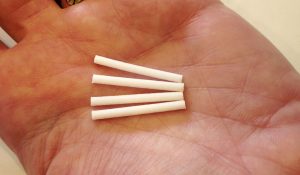 Some have called it a “game-changer”; a revolutionary medication in the treatment of opioid addiction. Approved by the FDA last May, Probuphine is said to bring a “ray of hope” to the medical community and addictions field throughout our country. So, what is this drug, why is it so noteworthy, and could there be something we are missing?
Some have called it a “game-changer”; a revolutionary medication in the treatment of opioid addiction. Approved by the FDA last May, Probuphine is said to bring a “ray of hope” to the medical community and addictions field throughout our country. So, what is this drug, why is it so noteworthy, and could there be something we are missing?
What Is Probuphine?
Similar to Suboxone and Subutex, Probuphine is made up of one key drug, buprenorphine. Buprenorphine is a partial opioid agonist which binds to the same brain receptors has heroin. Although this drug has what they call a “ceiling effect,” the likelihood of abuse and physical dependence are common. Since the launch of buprenorphine, countless stories have surfaced of opioid addicts becoming addicted to this medication; one that was intended to relieve their addiction. While almost chemically identical to Subutex, Probuphine differs to Suboxone, in that Suboxone is a combination of both buprenorphine and naloxone. One major reason for combining the two chemicals was to further prevent the likelihood of abuse and injection.
So, how is Probuphine different from these medications, making it the notable “game-changer” so many are raving about? Rather than it coming in the form of a sublingual film or pill, as Suboxone and Subutex do, Probuphine is designed to be implanted under the patient’s skin, dispersing a maintenance level, low-dosage of buprenorphine for a period of six months. While other forms have known to have a higher rate of abuse and diversion, the intention behind the implant is to deter such occurrences, while easing withdrawal symptoms and assisting in an opioid user’s cravings.
Each matchstick-size Probuphine implant contains 80 milligrams of buprenorphine. Four of these implants are inserted into the upper arm of each patient, which is done so by a certified physician. In order to qualify for the treatment, a patient must have already achieved clinical stability on either a Suboxone or Subutex regimen of 8 mg or less.
More To Come?
Medication-Assisted Treatment is not a new concept. Methadone, Suboxone, Naltrexone, Antabuse, and now Probuphine; you name it, pharmaceutical companies have tried it. With the promise that these medications would save addicts from themselves, many jumped on the bandwagon of opioid blockers and substitutions. We do not insinuate that all of these medications are completely detrimental to the treatment process. When clinically appropriate and necessary, some can be a beneficial tool, such as in the detoxification process. Nevertheless, patients are often left on these programs long term without clinical intervention or supervision, only furthering their dependence.
Most recently we heard of a young female professional who attempted to enter drug and alcohol treatment for her opioid addiction. After many failed attempts with treatment, recovery, and maintenance programs, she decided to ask her physician about a Probuphine program. Since she qualified for the drug, she soon found herself with 4 tiny implants in her upper arm. Approximately 3 months into her maintenance program, this woman had not seen much of a change…actually, things had gotten worse. Although on an opioid-blocker, she still craved and obsessed over using, eventually beginning to abuse Xanax and injecting heroin once more. Withdrawal symptoms or “dope-sickness” had gotten increasing worse, with the onset becoming sooner and at greater levels of discomfort. One major side-effect to using an opioid in conjunction with buprenorphine is precipitous withdrawal, so for her to experience such levels of discomfort is not uncommon.
Needles s to say, this young woman eventually hit a breaking point and sought help once more. What she found was almost baffling. Detoxification and inpatient treatment providers she contacted were unable to help; she was turned away when she needed help the most. There was no way for these centers and their physicians to properly detox and stabilize this woman, when she was already receiving a daily dose of buprenorphine. Furthermore, only a certified physician that is trained in the removal of the implant is qualified to do so; for a facility to attempt this may have only done more harm than good. Unfortunately, she had to be referred back to her prescribing physician.
s to say, this young woman eventually hit a breaking point and sought help once more. What she found was almost baffling. Detoxification and inpatient treatment providers she contacted were unable to help; she was turned away when she needed help the most. There was no way for these centers and their physicians to properly detox and stabilize this woman, when she was already receiving a daily dose of buprenorphine. Furthermore, only a certified physician that is trained in the removal of the implant is qualified to do so; for a facility to attempt this may have only done more harm than good. Unfortunately, she had to be referred back to her prescribing physician.
And Yet Another Example
With how long Suboxone has been around and the plethora of stories you hear regarding the drug’s dangers, we question, how this will be any different? Time and time again, these practices prove to only further opioid dependence and prolong the inevitable. With little research done thus far, many concerns arise when speaking of this “wonder drug.” Where does a Probuphine patient end up after the implant has been removed? Are they being weaned off of the drug throughout the 6 months or do they get a static dose every day for that time period? With drug dependence being a major side effect to prolonged buprenorphine use, it’s safe to assume one would need to undergo detoxification after the implant is removed.
Furthermore, we question the qualifications each participant needs to meet. In order to be prescribed Probuphine, each patient must be clinically stable and successful on a Suboxone or Subutex program. If an individual is “successful” and “stable” on another opioid-blocker, why would they need an implant in the first place? These are just a few examples as to how Probuphine is irrefutably counter-productive to the recovery process.
In keeping with the idea of fighting against the drug epidemic, is it too bold to believe that these attempts of “treatment” are simply a diversion to lower the death toll? Yes, we are absolutely sensitive to the fact that thousands are dying every day; 33,000 in 2015 to be exact. Nonetheless, the government’s “smoke and mirrors” approach is nothing more than that; a tactic; a ploy. In the case of harm reduction, these drugs do their job; keeping the addict alive for a period of time.
At the end of the day, addicts are not receiving quality treatment. Yes, they may be alive, which only promotes Big Pharma’s argument of success, but many find themselves in a deeper hole than when they began. Dependent upon yet another drug, fearing withdrawal, and unable to receive help. There is no quality of life for someone in that situation. Continuing a regimen such as this for 6 months or more is not only unwarranted, but down right detrimental to the individual. Once again, we have found yet another example of a failed “cure.”
Contact Clearbrook Today
Opioid and heroin addiction has been on an uptick for the last several years. More are becoming addicted, many are dying, and many are taking their chance at medication-assisted treatment. Often times, these individuals are finding themselves trapped in a perpetuating cycle of addiction. At Clearbrook, we have found another way; a way of life free from ALL mood and mind-altering substances.
If you or someone you know is struggling with addiction or alcoholism, please allow us to help. With customized detox protocols and treatment programs, we have been able to help the chemically dependent person rebuild their life for more than 40 years. Contact our Admissions Specialists today and get on the road to recovery.







